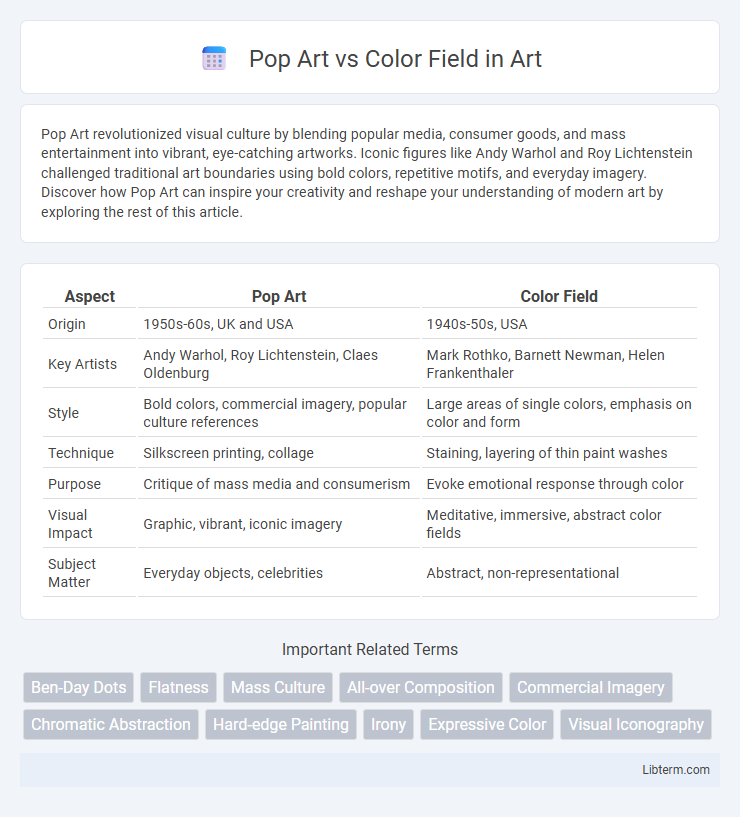Pop Art revolutionized visual culture by blending popular media, consumer goods, and mass entertainment into vibrant, eye-catching artworks. Iconic figures like Andy Warhol and Roy Lichtenstein challenged traditional art boundaries using bold colors, repetitive motifs, and everyday imagery. Discover how Pop Art can inspire your creativity and reshape your understanding of modern art by exploring the rest of this article.
Table of Comparison
| Aspect | Pop Art | Color Field |
|---|---|---|
| Origin | 1950s-60s, UK and USA | 1940s-50s, USA |
| Key Artists | Andy Warhol, Roy Lichtenstein, Claes Oldenburg | Mark Rothko, Barnett Newman, Helen Frankenthaler |
| Style | Bold colors, commercial imagery, popular culture references | Large areas of single colors, emphasis on color and form |
| Technique | Silkscreen printing, collage | Staining, layering of thin paint washes |
| Purpose | Critique of mass media and consumerism | Evoke emotional response through color |
| Visual Impact | Graphic, vibrant, iconic imagery | Meditative, immersive, abstract color fields |
| Subject Matter | Everyday objects, celebrities | Abstract, non-representational |
Introduction to Pop Art and Color Field
Pop Art emerged in the mid-1950s as a bold movement characterized by its vivid use of popular culture imagery, including advertising, comic strips, and mundane consumer goods, reflecting society's fascination with mass media and consumerism. Color Field painting, developing around the same period, emphasizes large areas of solid, flat color intended to evoke emotional resonance and spiritual contemplation through simplicity and abstraction. These two movements contrast sharply, with Pop Art's focus on recognizable iconography and Color Field's pursuit of pure color experience.
Historical Origins and Development
Pop Art emerged in the mid-1950s in Britain and the United States, characterized by its focus on popular culture and mass media imagery, reflecting the post-war consumer boom and the rise of advertising. Color Field painting developed in the late 1940s and 1950s, primarily in New York, emphasizing large expanses of solid color to evoke emotional responses, influenced by Abstract Expressionism and artists like Mark Rothko and Barnett Newman. Both movements challenged traditional artistic conventions but diverged in approach, with Pop Art using figurative imagery and Color Field focusing on pure color and form.
Key Artists and Influencers
Key artists in Pop Art include Andy Warhol, Roy Lichtenstein, and Claes Oldenburg, who emphasized popular culture and commercial imagery through bold colors and graphic styles. In contrast, Color Field painting features influential figures such as Mark Rothko, Barnett Newman, and Helen Frankenthaler, known for their large expanses of flat, solid color intended to evoke emotional responses. Both movements significantly shaped modern art by challenging traditional aesthetics and exploring new visual languages.
Defining Aesthetic Characteristics
Pop Art features bold imagery, vibrant colors, and popular culture references, often utilizing commercial techniques like silkscreen printing to create visually striking, accessible artwork. Color Field painting emphasizes large, flat areas of color with subtle tonal variations and minimal forms, aiming to evoke emotional responses through pure color experience rather than figurative representation. Both movements prioritize color impact, but Pop Art integrates recognizable icons while Color Field explores abstraction and chromatic immersion.
Techniques and Materials Used
Pop Art utilizes bold, vibrant colors and commercial techniques such as silkscreen printing and collage, often incorporating mass-produced imagery and everyday objects to critique consumer culture. Color Field painting emphasizes vast expanses of solid, flat color applied with techniques like staining or soaking unprimed canvas to create immersive, uniform fields and subtle color interactions. While Pop Art relies on sharp, graphic lines and mixed media to evoke popular iconography, Color Field focuses on simplicity and emotional resonance through large-scale monochromatic or softly graded color planes.
Iconography and Subject Matter
Pop Art features bold, recognizable imagery drawn from popular culture, including advertisements, celebrities, and comic strips, emphasizing mass media and consumerism. Color Field painting centers on large swaths of solid color, abstract shapes, and minimal iconography, focusing on evoking emotion through color rather than specific subjects. While Pop Art communicates through identifiable icons and narrative elements, Color Field prioritizes pure color experience and spatial depth over representational content.
Cultural and Social Context
Pop Art emerged in the 1950s and 1960s as a vibrant response to consumer culture and mass media, reflecting and critiquing post-war American society's obsession with advertising, celebrity, and popular entertainment. Color Field painting, developing concurrently, emphasized large swaths of color intended to evoke emotional responses and spiritual contemplation, reacting against the complexity of Abstract Expressionism and mirroring a desire for simplicity during Cold War anxieties. Both movements shaped and were shaped by their cultural environments, with Pop Art engaging in social commentary through iconic imagery, while Color Field sought introspective depth amidst societal tensions.
Pop Art vs Color Field: Visual Impact
Pop Art utilizes bold colors, recognizable imagery, and commercial motifs to create an immediate visual impact that is both vibrant and accessible, engaging viewers with familiar cultural icons. In contrast, Color Field painting emphasizes large expanses of pure color and subtle tonal variations, fostering a meditative and immersive visual experience through simplicity and abstraction. While Pop Art confronts with graphic intensity and narrative content, Color Field relies on color saturation and spatial depth to evoke emotional responses.
Influence on Contemporary Art
Pop Art's bold use of popular culture imagery and commercial techniques reshaped contemporary art by challenging traditional boundaries between high art and mass media. Color Field painting's emphasis on large expanses of color and emotional resonance influenced minimalist and abstract art movements by prioritizing pure visual experience. Both movements continue to inspire artists exploring identity, perception, and the relationship between art and society.
Legacy and Lasting Significance
Pop Art revolutionized the art world by challenging traditional boundaries between high art and popular culture, leaving a lasting legacy evident in advertising, fashion, and contemporary media. Color Field painting reshaped perceptions of color and space through vast, immersive canvases, influencing minimalist and abstract art movements. Both styles continue to inspire artists and collectors, underscoring their significant impact on 20th-century art history.
Pop Art Infographic

 libterm.com
libterm.com